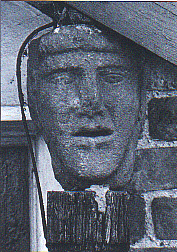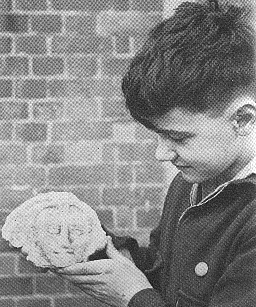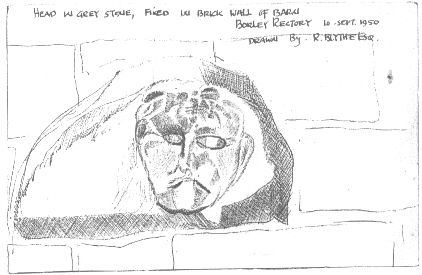Face in the Wall
by Barbara Clements
The other day I was in a bookstore and saw a book Haunted Britain and Ireland by Richard Jones. Borley was in it of course, but also something else sorta interesting caught my eye on page 103. It's a story titled "Image House" and I'm going to quote from it;

"There was a time when people were only too happy to settle their differences, or seek diabolical revenge, by using "sympathetic" or "image" magic. Today this is better known as voodoo, and is often associated with people sticking long needles into wax effigies of those who have offended them. The weathered stone images that adorn the walls of Bunbury's Image House are a vivid reminder of the days when any form of effigy would do. Each carving is thought to represent the officials responsible for sentencing a poacher to transportation in the 18th century. On his release and subsequent return to England, the vengeful poacher is said to have created these impressive stone reliefs of his punishers, and spent the remainder of his life heaping all manner of diabolical curses upon the figures, in the hope that his malevolent wishes would be visited upon their real-life counterparts"!
Next to this paragraph is a photo of one of these 'figures' and it reminds me very much of the odd little 'face in the wall' found on the stable wall at Borley!!! (photo courtesy of the Fortean Picture Library)
It really does seem entirely possible as they think the Borley face was from the 18th century, and the Image House face is also from the 18th century. Perhaps it was a practiced magic spell back then by a small number of persons and this Image House isn't the only place it was ever done before. It's so medieval and fascinating! The fact that it was picked up and kept on the site by Harry is due to his lack of knowledge of it, and maybe part of the spell. Who is was against is another mystery, as it is old and maybe originally from the Herringham Rectory or even earlier. At any rate it's also interesting that the 'face' didn't get destroyed, as if the 'spell' included a protection on it's image.
Borley Postscript by Peter Underwood. Haslemere: Whitehouse Publications, 2001. pp. 106, 127-29.
The Ghosts of Borley by Peter Underwood. South Devon: David & Charles, 1973. pp. 104, 209-11.

In August 1950 a new discovery was made at Borley. The find is best described in a letter James Turner sent me dated 24th August 1950:
This morning while walking from the cottage at Borley into the garden, passing the dahlia bed and along the path across the old Bull orchard, which is bounded on one side by the brickwork of the stables, I noticed for the first time a break in the brickwork. It looked as if someone in the past had cut a hole there and filled it with cement. On going closer (to see why anyone would want to make a hole at eye level) I discovered that what I had taken for cement was, in fact, a carved stone face built into wall at the time of the building of the shed. The face is clearly defind though very old. The odd thing, to me, is that for three years or more I have been up and down the path and nedver noticed it. I am going to dig beneath it to see it it marks the spot of anything. It is a double brick wall and I hope to remove a brick on the other side and see if there is anything behind it.
Photo: Terry Bacon with 'Face in the Wall,' about 1960.
. . . .Mr. Turner did, in fact dig into the ground below the 'face' and explored the cavity behind it but discovered nothing unusal.

On 10 September 1950, we received from Ronnie Blythe a sketch of the 'face.' . . . . .Visiting Borley on Sunday 24 September 1950. . . . Peter Underwood was able to examine the 'face' closely. He also met Mr. Blythe and was able to congratulate him on an excellent drawing. The 'face' appeared to be medieval and was seven-and-a-half inches across at its widest part, five- and-three-quarters inches high and six feet from ground level. . . . . . On a visit to Chilton Lodge on 8 July 1951, we learned that Miss Ethel Bull remembered the 'face.' She believed that it was found lying about when the wall was being built [c. 1863] and, probably at the suggestion of one of the children, was built into the wall. It may well, therefore, be a remnant of a building that stood originally on the Rectory site or possibly part of a former gravestone.
I don't know what happened to the stone face, but I know the subsequent owners, the Bacons, had it. I rather think it was built into another wall somewhere. I still have the original drawing. - Peter Underwood letter to Vincent O'Neil, 6 January 2003.
Borley photos courtesy of Peter Underwood. These photos may not be reproduced in any format for any purpose without the expressed, written consent of Peter Underwood.


